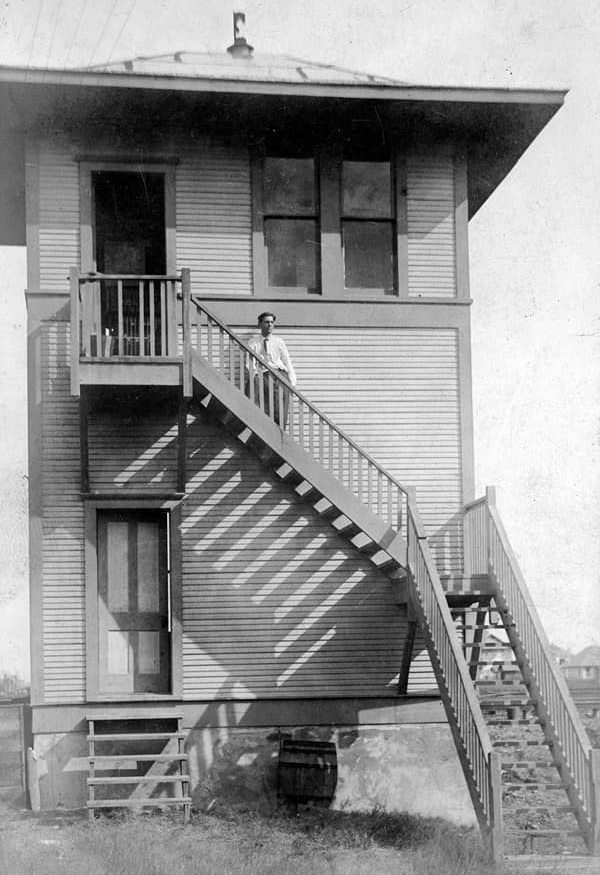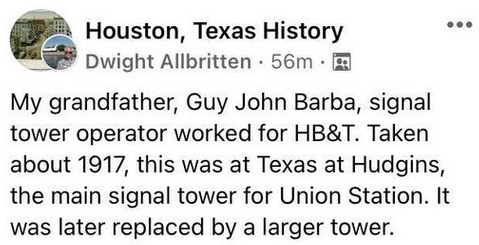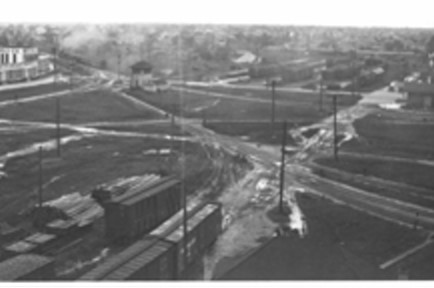Texas Railroad History - Tower 116 - Houston (Union Station)
The Houston Belt & Terminal Railway interlocking tower at Houston
Union Station

Above: John W. Barriger III
snapped this photo from the rear platform of his business car as it
crossed Texas Ave., probably in the late 1930s or early 1940s (the model year of the truck has
not been determined.) Barriger's train approached the entrance tracks to Union
Station from the northeast, and it was most likely slowing onto an alignment
that would allow it to back into the Union Station passenger terminal. The
camera's view is to the north past Tower 116 toward the Cheek Neal Coffee Building. (John
W Barriger III National Railroad Library image IGN068)
Below Left: In this pictorial explanation of the
above image, the corner of the Cheek Neal Coffee Building would be located about
where the orange oval appears at top of the diagram. Although the 1962 aerial
imagery used in the diagram dates to least twenty years after Barriger's photo,
the tower remained in place and there had been little or no change to the nearby
tracks.
Below Right: The Cheek Neal Coffee Building was built in
1917 and housed a Maxwell House Coffee facility for many decades. It still
stands and is on the
National Register of Historic Places. (Google Street View, Jan. 2020)



Above: Barriger took this
photo as his train was departing Union Station. The vehicles date the photo to
1940 or later. The train is curving northeast,
but the camera is facing south-southeast. Barriger took it from the rear platform of his business car shooting off the right side with the camera aimed slightly forward (i.e., to the left
in the photo,
the direction his train was moving.) The
one-story building beside Tower 116 appears to be a maintenance hut or a storage
barn. The photos in the Library numbered between the one at the top of the page
and this one do not reveal any clues as to whether they were taken on the same
trip. (John W Barriger III National Railroad Library
photo IGN081) Below: Likely
taken a few seconds after the above photo, Barriger is now looking to the
southwest down the track that ran along the southeast side of Tower 116.
Barriger's train has come onto the main line heading north where it will
soon cross Buffalo Bayou, most likely on the bridge of the International & Great
Northern Railway. (John W Barriger III National Railroad Library photo IGN083)

Below Left: pictorial explanation of the scene in the
image second above (IGN081) Below Right:
pictorial explanation of the scene in the image immediately above (IGN083)


Houston was served by numerous railroads as it overtook
Galveston to become the principal city of commerce in Texas. Houston's growth
era of railroading was roughly the half-century from 1875 to 1925. The various
railroads that arrived during that period can be generally segregated into
four groups: Southern Pacific (SP) operating through its Texas-based
subsidiaries; the Gulf Colorado & Santa Fe (GC&SF) Railway, a Texas subsidiary
of the well-known Atchison, Topeka & Santa Fe Railway; the railroads associated
with native Texan B. F. Yoakum, principally the Trinity & Brazos Valley (T&BV)
and several others known collectively as the Gulf Coast Lines; and the railroads associated with Jay Gould which
were eventually consolidated into the Missouri Pacific (MP) family. All
four groups had a significant presence in Houston and they understood the
potential benefit of a metropolitan switching railroad to facilitate freight
interchange. This recognition culminated in the creation of the Houston Belt & Terminal (HB&T) Railway
in 1905.
Four railroads founded HB&T, specifically the GC&SF and three of Yoakum's railroads (the
St. Louis, Brownsville & Mexico, the Beaumont, Sour Lake & Western, and the
T&BV.) SP's four Houston area railroads did not participate in HB&T's
ownership nor did any of the Gould railroads even though Houston was served at
the time by three of them. HB&T's charter included constructing "Union Station" downtown to support passenger service for
the founding railroads (plus any other railroads that could be lured to use it.) With HB&T's ownership lacking direct participation of the Gould and SP
railroad groups, Houston became the rare city that hosted rail passengers at
both "Union Station" and "Grand Central Station" (used by
Southern Pacific), not to mention
at least two other
passenger stations that remained active for awhile.
HB&T proceeded with
Union Station's design, employing the American Construction Company of St. Louis
and the New York architectural firm of Warren and Wetmore.
To accommodate the passenger terminal, Railway Express facility, coach yard, and access tracks, Union Station required a sizable
footprint. HB&T had planned a one million dollar budget to complete the
entire project, but they consumed all of it just to acquire the land! (The price
was inflated by a synagogue
and several expensive homes that sat on the parcel.) Trains began using Union Station in August, 1910 and it was formally
dedicated on March 2, 1911, the 75th anniversary of Texas Independence Day (and
Sam Houston's 118th birthday.)
Below Left:
a 1913 illustration of the front of Union Station
Below Right: a similar Google
Street View from January 2020


In 1903, the Railroad Commission of Texas (RCT) began
publishing a list of commissioned interlocking towers each year in its Annual
Report. These lists show that HB&T constructed multiple towers around Houston over
many years. Surprisingly, none of those towers was known to provide interlocker
controls for Union Station until Tower 116 appeared in the list dated December
31, 1923, more than
thirteen years after passenger operations had commenced! This seems odd
(listing Tower 116's official commissioning date as March
14, 1924, more than two months in the future, just makes it extra odd!)
Normally, tower numbers were assigned by RCT as soon as the requesting railroad
provided notice of a planned interlocker installation. RCT appeared to have corrected the record somewhat when its
list dated December 31, 1925 adjusted Tower 116's commissioning to a date more than a
decade earlier, September 4, 1910. This 1910 date was
at least consistent with the approximate commencement of passenger operations at Union
Station. But an interlocker approval in 1910 should have corresponded to a tower
number in the low 80's (e.g. Tower 83, commissioned July, 1910.) Tower 116's initial commissioning date
in 1924 is consistent with
similar tower numbers issued about the same time (e.g. Tower
115 approved December, 1923.) Why would there be a 13-year mismatch between a tower
number and the adjusted approval date for its interlocker?
The simple
answer appears to be this: HB&T built an interlocking tower at Union Station
that most likely became operational on September 4, 1910, but they did not
request approval from RCT for the interlocker design nor did they request
authority to commence operations. They simply ignored RCT entirely. And why did
HB&T believe this was a reasonable course of action? Because HB&T
assumed that its Union Station tower was exempt from
RCT's approval authority. This exemption issue pertained
to the 1901 state law that gave RCT the responsibility to issue regulations
regarding safety systems for railroad grade crossings. The law specifically
granted RCT the authority "...to ascertain and define by its decree, the
mode of crossing to be made, when one
railroad company seeks to cross with its track or tracks the
track or tracks of another railroad company."
RCT dutifully followed state law and issued rules and regulations governing approvals for interlockers
as provided by state law, that is...when
the tracks of one railroad
company crossed the tracks of another railroad company
at grade. Although trains of many
different railroads accessed Union Station, the tracks were all
owned by HB&T. Regardless of how complex the switching and signaling
system might have been, the tower at Union Station was arguably exempt from
state law. There was, literally, no other railroad
associated with the tracks of any grade crossings at Union Station; they were
all HB&T tracks.
Whether Union Station should have been exempt was a policy issue
that RCT had to resolve based on their interpretation of their own rules and
state law. Was there a legal way for RCT to enforce an approval
requirement for interlocking systems that only controlled tracks of a single railroad? And as public policy,
should there be a requirement for RCT approval
of single-railroad interlocking systems? How RCT chose to address these legal
issues was particularly critical for large freight yards where railroads managed
complex switching and signaling as they processed and interchanged freight cars,
often under customized "Yard Limits" rules of their own design.
Railroads saw no need for RCT approval of
any yard control
system they might choose to implement since there was simply no other company
involved. As all of Union Station's tracks belonged to HB&T,
they saw no
conflict with state law or RCT regulations, hence the interlocker wasn't
submitted to RCT for approval. RCT is fully aware of the existence of HB&T's tower and interlocker (after
all, their own personnel see it when they travel through Houston periodically by
train.) Whether RCT agreed that this HB&T tower was exempt is unknown, but there
is no evidence thus far uncovered that they ever attempted to invoke authority
to regulate, modify or terminate its operation. HB&T's
Tower 117 apparently got precisely the same
treatment, right down to being listed with the exact
same initial approval date and the exact same revised approval date. Tower 117 was HB&T's yard tower at New South Yard,
a freight yard more than three
miles from Tower 116. Although vastly different operationally (passengers vs.
freight), the only published difference between Towers
116 and 117 in RCT's lists was the initial number of interlocker functions, 77 for Tower
116 and 22 for Tower 117. Even their listed
locations, generically described as "H.B.T. Yards", was the same.
There is other
evidence of RCT's policy issue with respect to single-railroad interlocker
approvals. The first example is Tower 121, an SP yard tower in San Antonio
authorized in April, 1925, approximately one year after the reported formal commissioning
of Towers 116 and 117 in March, 1924. For Tower 121, SP wrote a letter to RCT
dated April 8, 1925 requesting interlocker design approval and a tower number
assignment. The letter states "This plant does not serve railroad
crossings at grade but is being constructed for our convenience and improvement
in operation." RCT approval was granted two days later. Obviously, SP
had learned of (and proactively elected to comply with) RCT's interpretation
of the rules. Santa Fe, on the other hand, did not. As they
upgraded their yard operations at Canyon in 1927,
RCT learned of it and wrote a letter to
Santa Fe inquiring as to when they could expect to see the plans. Santa Fe
responded with a letter explaining that with no
other railroad involved, they believed their yard interlocker was exempt from RCT
approval. RCT quickly set them straight! Santa Fe promptly complied at both
Canyon and Pampa.
The Tower 116 file at DeGolyer Library does not provide any obvious clues to
explain why the tower was commissioned by RCT in 1924, but other evidence shows
it to be related to construction of a new tower. The rapid growth of Houston
between 1910 and 1924 undoubtedly caused expanded operations at Union Station
with additional tracks supporting ingress and egress. It's reasonable to assume
that the tower HB&T built in 1910 to house the interlocker for Union Station was
significantly undersized for the interlocking plant expansion required for the
magnitude of passenger traffic being realized by the early 1920s. The Tower 116 file
has correspondence dated March 14, 1924 stating that the Union Station
tower is located at "Texas Ave. at Hutchins St." The date of this letter
became the listed commissioning date for the new tower, officially designated by
RCT to be Tower 116. The subsequent revision of the official commissioning date
to September 4, 1910 seems like an RCT Engineering Department decision to
account for the prior tower's successful operation for more than a decade, i.e.
the date it would have been approved by RCT had
they been given the opportunity (most likely its first day of operational use.)
It may also indicate that the original interlocking plant hardware was still in
use, most likely with expanded functionality. RCT's later lists reverted back to
the March, 1924 date for the official commissioning of Tower 116; the 1910
commissioning date only appeared in the two lists dated December 31 of years
1925 and 1926. It made more sense to recognize the March, 1924 commissioning
date since the newly assigned Tower 116 nomenclature was being applied to a
newly constructed tower (perhaps with a "used" interlocker), one that
undoubtedly had been designed and built with RCT approval.
 |
Left:
In May, 2021, this photo of the original Union Station tower was posted
to the Houston History group on Facebook by Dwight Allbritten. With his
post, Dwight provided the caption
below:

Below: The Russell
Crump Santa Fe Photo Collection contains this low resolution scan of a
photo taken in March, 1922 showing an unidentified interlocking tower
"near the corner of Texas Ave. & St. Emanuel St.". The tower is actually
closer to Hutchins St., but it's essentially in the same location as the
"new" Tower 116. The image is too small to make a precise comparison to
the photos taken more than a decade later by Barriger, but the March,
1922 date suggests that this is the original tower rather than the new
tower. Its appearance is certainly consistent with the tower photo at
left. The image is an elevated distant view of the tower taken from the
roof (or an upper floor) of the Cheek Neal Coffee Building visible in
Barriger's IGN068 photo. The photographer was facing slightly west of
due south about 700 ft. from the tower. (Russell Crump photo, courtesy
Santa Fe Railway Historical and Modeling Society)
 |
According to rail historian David Bernstein, the
Tower 84 and Tower 116
interlockers were consolidated into Tower 117 in June, 1971. Thus, 1971 is a reasonable estimate for the year in which Tower
116 was dismantled. A 1973 image from historicaerials.com shows the side
building intact but the tower is no longer beside it.
 |
Left:
This glimpse of Tower 116 (and the small building behind it) is
in the distance of a larger George Werner photo dated June 16, 1968. The photo
appears in Steve Allen Goen's book Santa Fe in the Lone Star State, Volume One - 1949-1969
[Four Ways West Publications, 2000]. Compare it to the same view of the tower in Barriger's
photo (right). Other
than paint and finish, the tower's short side is unchanged. The long
side, however, extends to the right so that the bottom step of the
staircase no longer aligns with the far edge of the tower. There are now
eight upper floor windows instead of five, and a ground floor door has
been added in the new section. What could account for the tower's
expansion? On October 17, 1947, Interlocker 116-A was added to Tower 116 to
control a nearby I-GN/GH&H crossing. The use of separate interlocker nomenclature implies
that an additional plant was installed in the tower. Earlier
changes approved on October 15, 1944 to control the HB&T/I-GN
crossing at Commerce St. and the
HB&T/GH&H crossing on Canal St. might
have consumed the spare capacity of the original interlocker. Thus, enlarging the tower to accommodate
the additional 116-A interlocker and its operator controls could easily explain the
observed changes to Tower 116. |
 |
Historic Map, Tower 116


Above: This image from the
1924 Sanborn Fire Insurance map of Houston shows an interlocking
tower (see magnification at right)
located near the intersection of Texas Ave. and Hutchins St. at the east edge of
Union Station. The map depicts two structures, the
2-story tower and the 1-story building beside it to the west.
At the time that passenger trains were taken over by Amtrak in 1971, there were still two passenger
stations being used in Houston. SP's Grand Central Station, built in 1934, had
been replaced in 1959 by a new station that continued hosting SP's Los
Angeles - New Orleans Sunset Limited, now operated by Amtrak. At the same time,
Union Station continued to host Amtrak's version of Santa Fe's Chicago -
Galveston Texas Chief passenger service, later renamed the Lone
Star. Operating out of two different passenger stations in Houston made no sense (not
that it ever did!), and Amtrak's limited budget
could not afford to maintain operations at two facilities. The Lone Star
was switched to SP's station on July 31, 1974 and as of that date, Union Station
was no longer used for scheduled passenger service.
Below Left:
Houston Union Station is now part of Minute Maid Park, the home of major league
baseball in Houston. It is therefore not surprising that the former site of
Tower 116 (now in a stadium parking lot!) no longer appears to correlate with any historic railroad activity. From 1962 historicaerials.com imagery, the precise Lat./Long. of Tower 116 can be
determined as 29.75413 degrees North, 95.35231 degrees West. This correlates to
the red marker on this Google Maps snippet. Below
Right: This Google Street View from June, 2019 shows a tree
growing about where the southwest face (short side) of the tower stood adjacent
to Texas Ave.
Note the Cheek Neal Coffee Building visible in the distance.


Below:
This uncredited 1938 aerial photo facing west into downtown Houston has been
annotated to show Tower 116 and nearby streets.


















